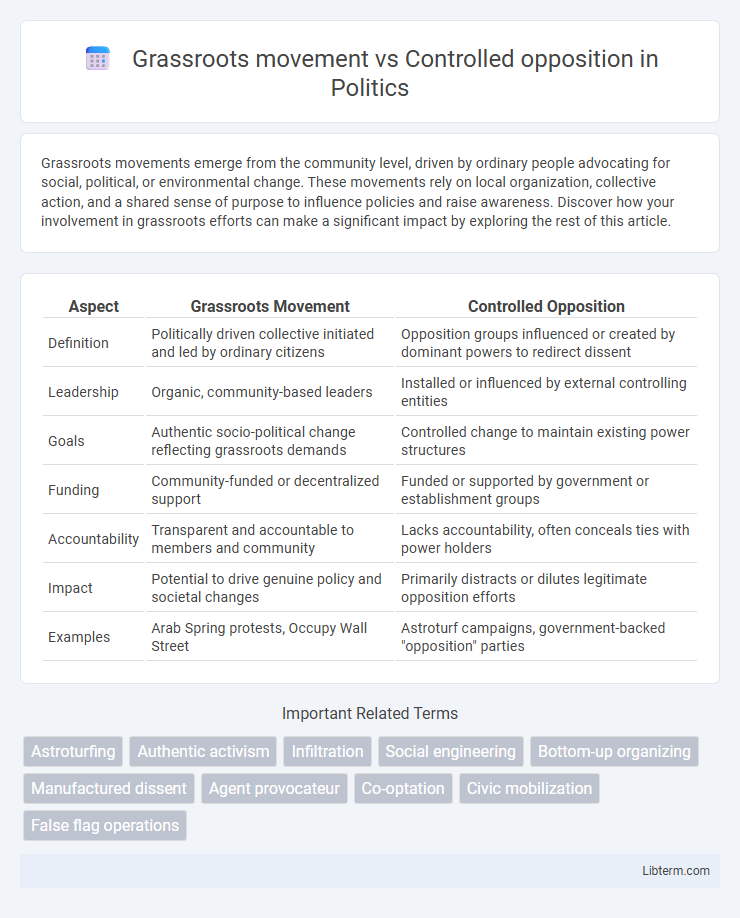Grassroots movements emerge from the community level, driven by ordinary people advocating for social, political, or environmental change. These movements rely on local organization, collective action, and a shared sense of purpose to influence policies and raise awareness. Discover how your involvement in grassroots efforts can make a significant impact by exploring the rest of this article.
Table of Comparison
| Aspect | Grassroots Movement | Controlled Opposition |
|---|---|---|
| Definition | Politically driven collective initiated and led by ordinary citizens | Opposition groups influenced or created by dominant powers to redirect dissent |
| Leadership | Organic, community-based leaders | Installed or influenced by external controlling entities |
| Goals | Authentic socio-political change reflecting grassroots demands | Controlled change to maintain existing power structures |
| Funding | Community-funded or decentralized support | Funded or supported by government or establishment groups |
| Accountability | Transparent and accountable to members and community | Lacks accountability, often conceals ties with power holders |
| Impact | Potential to drive genuine policy and societal changes | Primarily distracts or dilutes legitimate opposition efforts |
| Examples | Arab Spring protests, Occupy Wall Street | Astroturf campaigns, government-backed "opposition" parties |
Understanding Grassroots Movements
Grassroots movements emerge organically from community members advocating for social, political, or environmental change without centralized control, relying on widespread participation and local leadership to drive momentum. These movements prioritize authentic representation and collective action, contrasting with controlled opposition groups, which are often infiltrated or manipulated by external forces to undermine genuine activism. Understanding grassroots movements involves recognizing their decentralized nature, community-driven goals, and emphasis on empowerment through direct engagement rather than hierarchical directives.
Defining Controlled Opposition
Controlled opposition refers to a political or social group that appears to challenge the established power but is covertly influenced or created by that same power to manipulate, discredit, or redirect genuine dissent. Unlike grassroots movements, which arise organically from the community to express authentic concerns and demands, controlled opposition serves as a strategic tool to maintain control and suppress authentic activism. Identifying controlled opposition involves analyzing patterns of infiltration, funding sources, leadership ties, and inconsistent messaging that undermine genuine opposition efforts.
Key Characteristics of Grassroots Movements
Grassroots movements originate organically from community members, emphasizing local participation, collective action, and bottom-up decision-making processes. These movements depend on decentralized leadership and volunteer-driven efforts, often advocating for social or political change without external control or funding. Transparency, authenticity, and a strong connection to community needs are key characteristics distinguishing grassroots movements from controlled opposition groups.
Signs of Controlled Opposition
Signs of controlled opposition include consistent alignment with establishment goals despite apparent dissent, limited impact on real policy changes, and structured leadership often linked to powerful interests. Grassroots movements typically emerge organically with decentralized leadership and genuine community-driven agendas, contrasting with controlled opposition that manipulates public perception to maintain the status quo. Monitoring funding sources, communication channels, and strategic responses to critical issues can help identify controlled opposition efforts.
Historical Examples of Grassroots Movements
Grassroots movements have played pivotal roles in shaping history through community-driven efforts such as the American Civil Rights Movement, which mobilized ordinary citizens to challenge systemic racism and segregation. The Indian Independence Movement, led by Mahatma Gandhi, exemplifies grassroots activism through widespread nonviolent resistance and civil disobedience against colonial rule. These movements contrast with controlled opposition, where entities are covertly manipulated by established powers to undermine genuine activism from within.
Notable Cases of Controlled Opposition
Notable cases of controlled opposition include the infiltration of civil rights movements by government agencies such as the FBI's COINTELPRO operation against the Black Panther Party, aiming to disrupt and discredit activists. Another example is the anti-war movement during the Vietnam era, where intelligence agencies placed agents to sow discord and weaken protest efforts. These instances highlight how controlled opposition can manipulate grassroots movements for political or strategic objectives.
Impact on Social and Political Change
Grassroots movements drive authentic social and political change by mobilizing community members and amplifying marginalized voices, creating organic pressure on institutions. Controlled opposition, often orchestrated by established powers, can undermine genuine activism by creating false dissent, co-opting movements, and diluting their impact. The contrast between these forces significantly shapes the legitimacy and effectiveness of efforts to address systemic issues and influence policy reforms.
Strategies for Identifying Authentic Movements
Authentic grassroots movements exhibit organic growth with diverse community involvement, transparent leadership, and consistent messaging aligned to genuine local concerns. Controlled opposition often reveals centralized funding sources, coordinated narratives that subtly align with establishment agendas, and lack of sustained grassroots support. Analyzing social media patterns, leadership backgrounds, and funding transparency provides key strategies for distinguishing true grassroots activism from manipulated opposition.
Risks of Infiltration and Manipulation
Grassroots movements face significant risks of infiltration and manipulation by controlled opposition, which can undermine their goals through covert influence and misinformation. Infiltrators may gather intelligence, sow discord, or redirect activism to serve hidden agendas, weakening the authenticity and effectiveness of genuine public mobilization. Awareness of these tactics is crucial for safeguarding organizational integrity and maintaining trust within grassroots initiatives.
Grassroots vs Controlled Opposition: Key Differences
Grassroots movements originate organically from community members advocating for change, emphasizing authentic representation and decentralized leadership. Controlled opposition refers to groups or individuals deliberately created or influenced by establishment forces to mimic dissent while maintaining the status quo. Key differences include the genuine origin and aims of grassroots efforts versus the manipulated, often deceptive nature of controlled opposition designed to undermine real activism.
Grassroots movement Infographic

 libterm.com
libterm.com